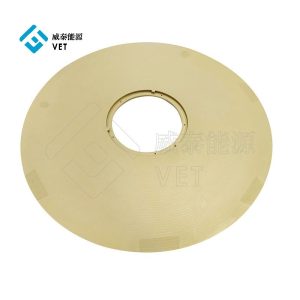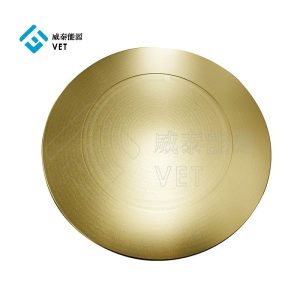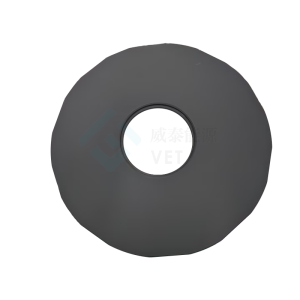Tantalum carbide (TaC) coating enhances material durability and heat resistance. The process uses a TaC coating machine to apply a uniform layer. This method, often involving cvd tac coating, ensures precision and reliability. Industries rely on tac coating for applications requiring extreme temperature tolerance and wear resistance, making it a critical technological advancement.

要点
- Tantalum carbide (TaC) coating makes materials stronger and heatproof. It is important for tools that need to work well under stress.
- Getting the surface ready, like cleaning and checking for damage, helps the TaC coating stick better.
- Setting up the TaC machine and adjusting settings is key. This ensures the coating is even and works properly.
Preparing the TaC Precursor
The preparation of the TaC precursor is a critical step in the coating process. This stage ensures the material used for the coating is of high quality and suitable for application. It involves synthesizing the precursor, preparing it into a usable form, and verifying its consistency.
Synthesizing the TaC Precursor
The synthesis of the TaC precursor begins with selecting high-purity tantalum and carbon sources. These materials undergo a controlled reaction in a high-temperature environment. The process forms tantalum carbide, a compound known for its exceptional hardness and heat resistance. Operators monitor the reaction closely to ensure the desired chemical composition. Any deviation can affect the coating’s performance.
Preparing the Precursor Slip
After synthesis, the TaC precursor is processed into a slip. This step involves mixing the precursor powder with a liquid binder. The binder helps the material adhere to the substrate during application. Technicians use precise measurements to achieve the correct ratio of powder to liquid. The resulting mixture must have a smooth, uniform texture. This ensures it can be applied evenly using the tac coating machine.
Ensuring Consistency for Application
Consistency plays a vital role in the coating process. The precursor slip must have the right viscosity and particle distribution. Technicians test the mixture to confirm these properties. Adjustments are made if necessary to meet the required standards. A consistent slip ensures the coating will bond effectively and provide uniform coverage.
Preparing the Substrate
Proper substrate preparation ensures the TaC coating adheres effectively and performs as intended. This step involves cleaning, inspecting, and optionally applying a pre-coat to the material.
Cleaning and Degreasing the Surface
Cleaning removes contaminants that could interfere with the coating process. Technicians use solvents or ultrasonic cleaners to eliminate grease, oil, and dirt. For stubborn residues, abrasive cleaning methods like sandblasting may be necessary. A clean surface ensures the TaC coating bonds securely, reducing the risk of peeling or uneven coverage.
Inspecting for Defects
After cleaning, the substrate undergoes a thorough inspection. Technicians check for cracks, scratches, or other imperfections that could compromise the coating’s performance. Visual inspection tools, such as magnifying lenses, help identify surface flaws. For critical applications, advanced techniques like dye penetrant testing or X-ray imaging may be used. Addressing defects at this stage prevents costly rework later.
Applying a Pre-Coat (Optional)
In some cases, a pre-coat layer enhances adhesion between the substrate and the TaC coating. This layer, typically a primer or bonding agent, creates a smoother surface for the coating to adhere to. Technicians apply the pre-coat using methods like spraying or dipping, ensuring even coverage. Once applied, the pre-coat must dry completely before proceeding to the next step.
By following these steps, the substrate becomes ready for the TaC coating process, ensuring optimal results.
Setting Up the TaC Coating Machine
Proper setup of the TaC coating machine ensures a smooth and efficient coating process. This step involves calibrating the machine, loading the substrate, and configuring the coating parameters.
Calibrating the Machine
Calibration ensures the TaC coating machine operates accurately. Technicians begin by checking the machine’s components, including nozzles, sensors, and control systems. They verify that all parts are clean and free of obstructions. Using calibration tools, they adjust the machine to meet the required specifications. This step ensures the machine delivers consistent coating thickness and uniformity. Regular calibration also minimizes errors during the application process.
Loading the Substrate
Loading the substrate into the TaC coating machine requires precision. Technicians secure the material on the machine’s holding platform, ensuring it remains stable during the process. Proper alignment is critical to achieving even coating coverage. They use clamps or fixtures to prevent movement. For automated systems, technicians program the machine to position the substrate correctly. This step prepares the material for the application phase.
Configuring Coating Parameters
Configuring the coating parameters tailors the process to the specific material and application requirements. Technicians input key settings, such as temperature, pressure, and coating speed, into the machine’s control panel. They refer to the material’s specifications to determine the optimal parameters. Testing the settings on a sample substrate ensures accuracy. Adjustments are made if the initial results do not meet quality standards.
By completing these steps, the TaC coating machine is ready for the application process. Proper setup ensures high-quality results and reduces the risk of errors.
Applying the TaC Coating

Initiating the Coating Process
The coating process begins with activating the tac coating machine. Operators start by verifying that all settings match the configured parameters. Once confirmed, they initiate the machine’s coating cycle. The machine applies the TaC precursor slip onto the substrate using techniques like spraying or dipping. The method depends on the machine’s design and the material’s requirements. Operators ensure the machine operates smoothly without interruptions. Any irregularities, such as uneven spray patterns or blockages, are addressed immediately to prevent defects.
Monitoring the Coating Application
During the application, technicians closely observe the process. They check for consistent coverage across the substrate. Advanced machines often include sensors or cameras that provide real-time feedback. Operators use this data to make adjustments if necessary. For manual systems, visual inspection ensures the coating is applied evenly. Regular monitoring minimizes errors and ensures the coating adheres properly to the substrate.
Ensuring Uniformity and Thickness
Uniformity and thickness are critical for the coating’s performance. Operators measure the coating layer using tools like micrometers or thickness gauges. They compare these measurements to the required specifications. If the layer is too thin or thick, adjustments are made to the machine’s settings. Consistent thickness ensures the coating provides optimal heat resistance and durability.
Post-Coating Heat Treatment
Post-coating heat treatment enhances the durability and performance of the TaC coating. This step involves controlled heating, optional carburization, and gradual cooling to stabilize the coated material.
High-Temperature Sectional Heat Treatment
High-temperature heat treatment strengthens the bond between the TaC coating and the substrate. Technicians place the coated material in a furnace, heating it to a specific temperature based on the material’s properties. The heat activates chemical reactions that improve adhesion and hardness. Operators divide the process into sections, heating each area uniformly to prevent thermal stress.
Technicians monitor the temperature and duration closely. Overheating can damage the coating, while insufficient heat may result in weak adhesion. This step ensures the coating achieves its full potential in terms of heat resistance and durability.
Interstitial Carburization (Optional)
Interstitial carburization introduces additional carbon atoms into the coating. This optional step enhances the material’s hardness and wear resistance. Technicians expose the coated material to a carbon-rich environment at high temperatures. The carbon atoms diffuse into the TaC layer, creating a denser and more robust structure.
This process requires careful control to avoid over-saturation, which can lead to brittleness. Operators adjust the carbon concentration and exposure time based on the desired properties.
Cooling the Coated Material
Cooling stabilizes the coated material after heat treatment. Technicians gradually reduce the temperature to prevent thermal shock, which can cause cracks or warping. Air cooling is common, but some materials may require controlled cooling in a furnace.
Proper cooling ensures the TaC coating retains its enhanced properties, making it ready for quality assurance and further use.
Final Quality Assurance
Inspecting the Coated Surface
Inspecting the coated surface ensures the TaC layer meets visual and structural standards. Technicians examine the material under proper lighting to identify surface irregularities. They look for defects such as cracks, bubbles, or uneven textures. Magnifying tools or microscopes help detect smaller imperfections that may not be visible to the naked eye.
For high-precision applications, advanced imaging techniques like scanning electron microscopy (SEM) provide detailed surface analysis. These methods reveal micro-level inconsistencies that could affect performance. Addressing these issues early prevents failures during use.
Performing Quality Assurance Tests
Quality assurance tests verify the coating’s durability and functionality. Technicians conduct adhesion tests to measure how well the TaC layer bonds to the substrate. They use tools like pull-off testers or scratch testers for this purpose. Thickness measurements ensure the coating meets the required specifications. Instruments such as ultrasonic thickness gauges or micrometers provide accurate readings.
Additional tests may include thermal resistance evaluations or wear resistance assessments. These tests simulate real-world conditions to confirm the coating’s performance. Each test provides valuable data about the coating’s reliability.
Documenting the Results
Documenting results creates a record of the coating’s quality. Technicians log inspection findings, test results, and any corrective actions taken. They use standardized forms or digital systems to maintain consistency. This documentation serves as proof of quality for clients and regulatory bodies.
Clear and detailed records help manufacturers track process improvements. They also provide a reference for troubleshooting issues in future production runs.
Packaging and Delivery
Packaging the Coated Material
Proper packaging protects the coated material from damage during storage or transportation. Technicians select packaging materials based on the size, weight, and fragility of the coated item. For smaller components, foam inserts or bubble wrap provide cushioning. Larger items often require custom crates or reinforced boxes.
Before packaging, technicians inspect the coated material one final time. They ensure the surface remains free of dust, moisture, or contaminants. Protective films or wraps are applied to shield the coating from scratches or environmental exposure. Labels indicating “Fragile” or “Handle with Care” are added to the packaging for extra precaution.
Preparing for Delivery or Use
Delivery preparation involves organizing the coated materials for shipment or immediate use. Technicians group items based on their destination or application. For bulk orders, pallets or containers streamline handling and transportation. Each package includes documentation, such as product specifications, handling instructions, and quality assurance certificates.
For materials intended for immediate use, technicians ensure they are ready for integration into the production process. This step may involve pre-assembly or additional cleaning. Clear instructions accompany the materials to guide end-users.
Maintaining Process Records
Accurate records ensure traceability and compliance with industry standards. Technicians document packaging details, delivery schedules, and customer requirements. Digital systems or spreadsheets simplify record-keeping and improve accessibility.
Records also include feedback from clients or end-users. This information helps manufacturers refine their processes and address any issues. Maintaining detailed records supports quality assurance and builds trust with customers.
The TaC coating process becomes straightforward when broken into manageable steps. Manufacturers can achieve durable, high-quality coatings by following this guide. These coatings enhance material performance, making them essential for industries requiring heat resistance. The tac coating machine plays a pivotal role in ensuring precision and reliability throughout the process.
よくあるご質問
What is the purpose of TaC coating?
TaC coating improves material durability and heat resistance. It protects surfaces from wear and extreme temperatures, making it essential for aerospace, industrial, and high-performance applications.
How does the TaC coating machine ensure uniformity?
The machine uses precise settings for temperature, pressure, and speed. Operators monitor the process and adjust parameters to achieve consistent thickness and even coverage.
Can TaC coating be applied to all materials?
Not all materials are suitable. The substrate must withstand high temperatures and bond with the coating. Technicians assess compatibility before starting the process.
For more product details, please contact steven@china-vet.com Or website: www.vet-china.com.







